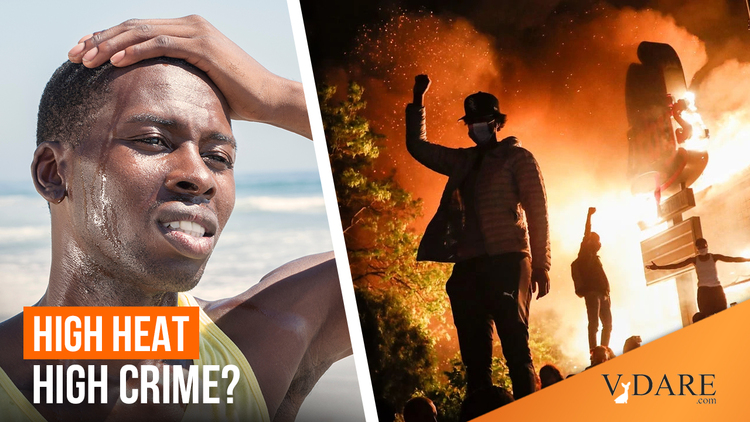


By Paul Kersey
01/05/2023
For some reason, climate change is only affecting black individuals to collectively commit gun violence across America.
That’s at the macro level. At the micro level, climate change is now the primary link to almost exclusive black gun violence in Kansas City, Missouri.
Structural racism, redlining and disinvestment… now joined by climate change as a reason for black violence:
Is climate change linked to gun violence? A new study shows how KC area is impacted, by Katie Moore, Kansas City Star, January 2, 2023
On the hottest day of 2022 in Kansas City, three people were shot and killed. Three more were shot and survived, the Kansas City Police Department said. The temperature clocked in at 101 degrees on July 23, according to Jared Leighton, a lead forecaster with the National Weather Service in Kansas City. With 171 homicides, this year became the second deadliest on record in Kansas City — and some of those fatal shootings may be linked to an unexpected cause: climate change.
Researchers analyzed more than 116,000 shootings in 100 cities and found that nearly 7% could be attributed to days with above-average temperatures, not only in the summer, but also at other times of the year when it was unseasonably warm. In Kansas City, Missouri, the percentage of shootings tied to days with above-average temperatures was 6.13%, while in Kansas City, Kansas, it was 7.86%, according to the study published last month in the Journal of the American Medical Association.
“An increase in warmer temperatures and more frequent extreme heat events due to climate change may create environments with higher risk of firearm violence in the future,” the study said. Researchers concluded that the findings “underscore the importance of exploring heat mitigation strategies as tools to reduce shootings.” Experts have theorized that warmer temperatures increase stress hormones and lead to more interactions between people.
“I think there are definitely higher volume call days when it’s hot outside but that’s also true when it’s just a nice day and not necessarily hot,” said Officer Donna Drake, a spokeswoman for KCPD. “There are more people out and about when the weather is nice.” Anecdotally, more violence occurs in the hotter months, said Janell Friesen, spokeswoman for the Unified Government’s Public Health Department. She noted that the study also touches on environmental justice. “Structural racism and discriminatory policies and practices have led to inequities in the impact of climate change and environmental hazards, including a greater impact on BIPOC (Black, Indigenous and people of color),” Friesen said. “The Health Department is working to better understand how it can tackle environmental justice issues, and how this connects to addressing other public health issues like violence.”
The study said redlining and disinvestment — issues the Kansas City area has long struggled with — often have left communities of color in areas with less green space and more asphalt. That can lead to the heat island effect, which increases temperatures. In an analysis of 60 cities, a report by Climate Central ranked Kansas City as having the seventh most intense summer heat island effect. Bridging the Gap has planted thousands of trees in an effort to reduce the heat island effect in Kansas City, which can increase temperatures in some neighborhoods by up to seven degrees, said executive director Kristin Riott.
“Priority number one in terms of heat island mitigation is those historically underserved areas,” she said. Not only do trees decrease the heat island effect, they also provide shade, help clean the air and have been shown to have a positive impact on mental health. One of the many benefits of trees could extend to helping reduce violent crime, Riott added. The Office of the City Auditor is currently looking at how Kansas City manages trees as one way to address climate change. A report is expected in January. Dr. Marvia Jones, director of the Kansas City Health Department, said the study’s findings aren’t surprising, but do “gives us a little bit more of a guide, I would say as to how we need to align our efforts.” She reiterated the importance of trees, calling it a “dual purpose intervention.” The health department and other local organizations are also working together to get an early start on programming for young people to ensure they “have access to positive things to do over the summer,” Jones said, adding that efforts are focused on underserved areas. Eighteen of the 2022 homicide victims in Kansas City were 18 years or younger and several juveniles were arrested in connection with murders this year in the metro.
So climate change isn’t color blind? Climate change doesn’t view as a social construct, but primarily targets black and brown individuals with its nefarious heat, inducing otherwise docile biopics to shoot and kill other colored people?
Is that the general thesis of this story?
More trees, less crime?